Table of Contents
The Bhutanese flag, also known as the flag of Bhutan, holds a significant place in the nation’s history and culture. With its vibrant colors and meaningful symbolism, it represents the Bhutanese identity and heritage. In this article, we will delve into the intriguing aspects of the Bhutan flag, its design, its historical background, and the symbolism behind its elements.
The Bhutan flag features a white dragon across a background divided diagonally from the lower hoist-side corner; the upper triangle is yellow and the lower triangle is orange. The dragon, known as the Druk (Thunder Dragon), symbolizes the protection of the country. The yellow color signifies the civil tradition and monastic system, while the orange represents the Bhutanese monarchy.
Bhutan Flag: Colors and Symbolism
- The flag of Bhutan features a white dragon across a diagonal background with the upper triangle being yellow and the lower triangle orange.
- The yellow color symbolizes the civil tradition, the spiritual aspect, and the monastic system that reflects the purity of internal thoughts and deeds.
- The orange color represents the Drukpas, traditions, and the monarchy, and is a symbol of the sacrificial spirit of the Bhutanese people.
- The white dragon, Druk, stands for the protection of the country, echoing the name Druk Yul (Land of the Thunder Dragon) – the native name for Bhutan.
- The flag’s design reflects the nation’s aspirations, cultural heritage, and unity among the Bhutanese people.
Flag of Bhutan
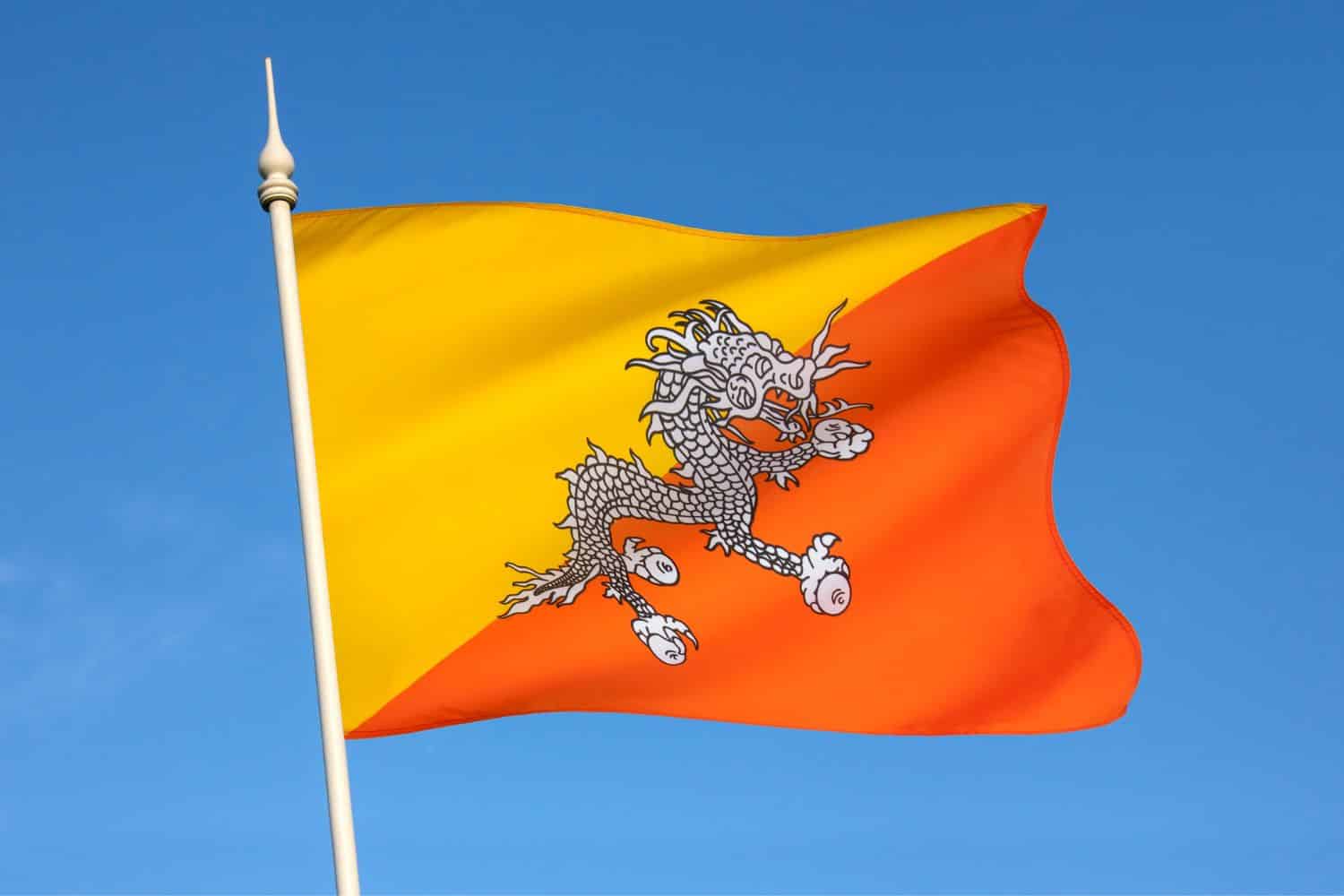
The flag stands as a powerful symbol that encapsulates the cultural significance and spirit of Bhutan. Its design consists of a divided diagonally formed field of yellow and orange, with a white dragon at the center. The yellow color symbolizes the authority of the King, reflecting the traditional governance and the richness of the Bhutanese monarchy. The orange color represents the Buddhist religion, honoring the spiritual foundation that has shaped Bhutanese society. The white dragon, known as the Druk, symbolizes the protection and purity of the country, and it holds jewels in its claws that stand for wealth and prosperity.
The history of the flag is intertwined with Bhutan’s rich heritage and the legacy of its monarchs and monks. While its origin dates back to the 19th century, the modern design was finalized in 1969, and it represents the unity and aspirations of the Bhutanese people.
Beyond its aesthetics, the flag from Bhutan carries deep symbolic meanings. The colors reflect the values and aspirations of the Bhutanese people, symbolizing authority, spirituality, and protection. The Druk, or thunder dragon, is a dominant figure in Bhutanese mythology, emphasizing the nation’s unique cultural identity and traditions. It embodies Bhutan’s cultural heritage and serves as a reminder of the nation’s strength and unity.
National Flag Etiquette and Protocol
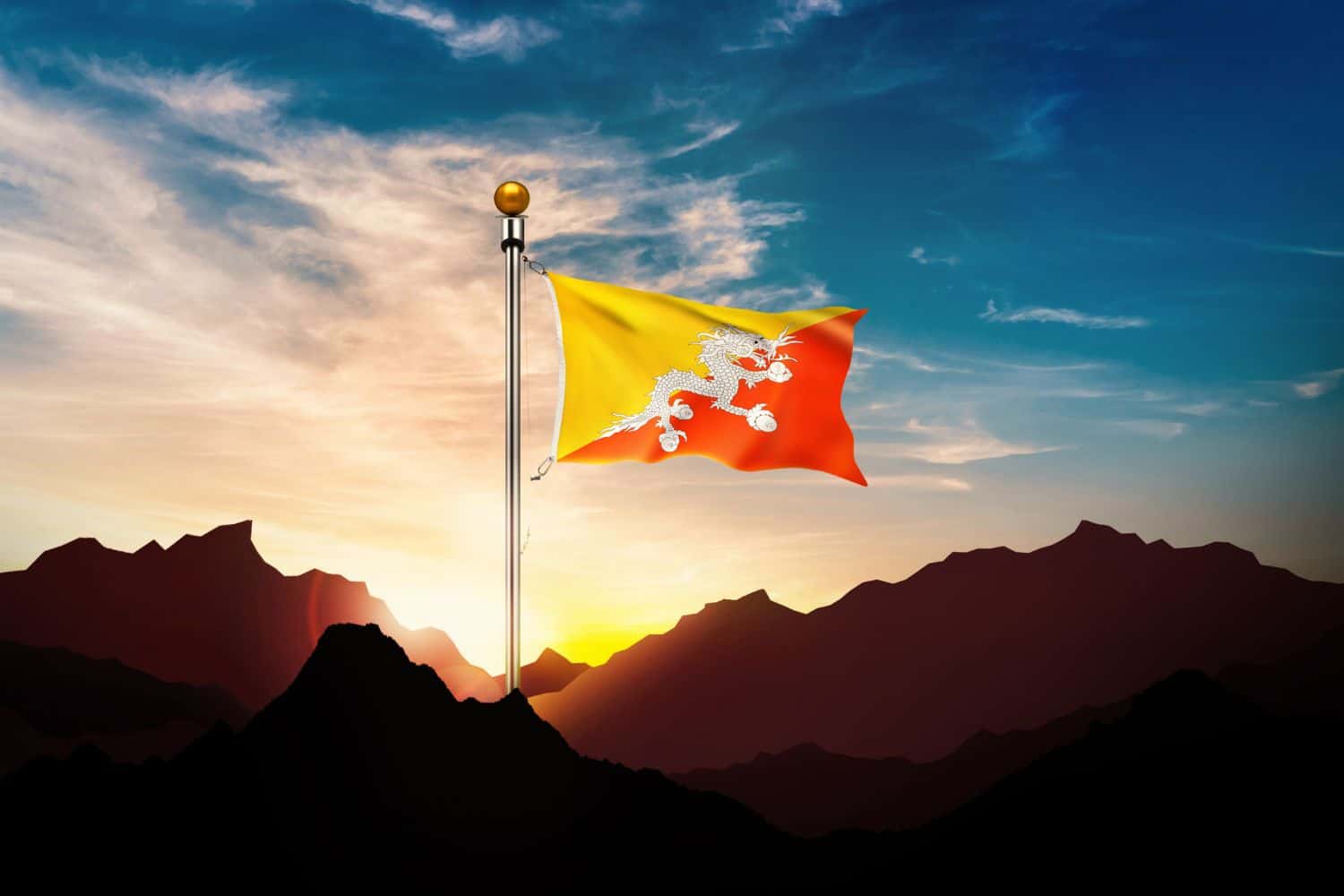
Respecting the proper usage and display of the Bhutanese flag is of utmost importance. Understanding flag etiquette is essential, especially during national events and ceremonies. Learn about the protocols governing the handling, hoisting, and lowering of the flag. Discover the appropriate procedures for retiring or handling damaged flags, ensuring they are accorded the respect they deserve.
- Proper Handling: The Bhutanese flag should be handled with care and respect, ensuring it is not allowed to touch the ground or floor. It should be held upright and not dragged.
- Hoisting and Lowering: When hoisting the flag, it should be raised briskly and lowered ceremoniously. It is customary to hoist the flag at sunrise and lower it at sunset, although this may vary depending on the occasion or specific guidelines.
- Displaying the Flag: The Bhutanese flag should be displayed with the dragon facing towards the hoist side, set against a yellow and orange background. It should be flown freely and not entangled or obstructed.
- Half-Staff: Lowering the flag to half-staff is a gesture of mourning or respect. This should be done on specific days of remembrance or when directed by authorities to honor national tragedies or the passing of significant figures.
- Flag Retirement: When a Bhutanese flag becomes damaged, torn, or worn out, it should be retired in a dignified manner. This can involve burning it in a respectful and solemn ceremony, following appropriate guidelines and local regulations.
- Flag Size and Placement: The size of the Bhutanese flag displayed should be proportionate to the size of the flagpole or display area. It is recommended to consult local guidelines or authorities for specific rules regarding flag size and placement.
- Respectful Disposal: If a flag cannot be retired through burning, it should be disposed of in a respectful manner. This can involve burying it or handing it over to authorized organizations that specialize in flag disposal.
Interesting Facts and Trivia
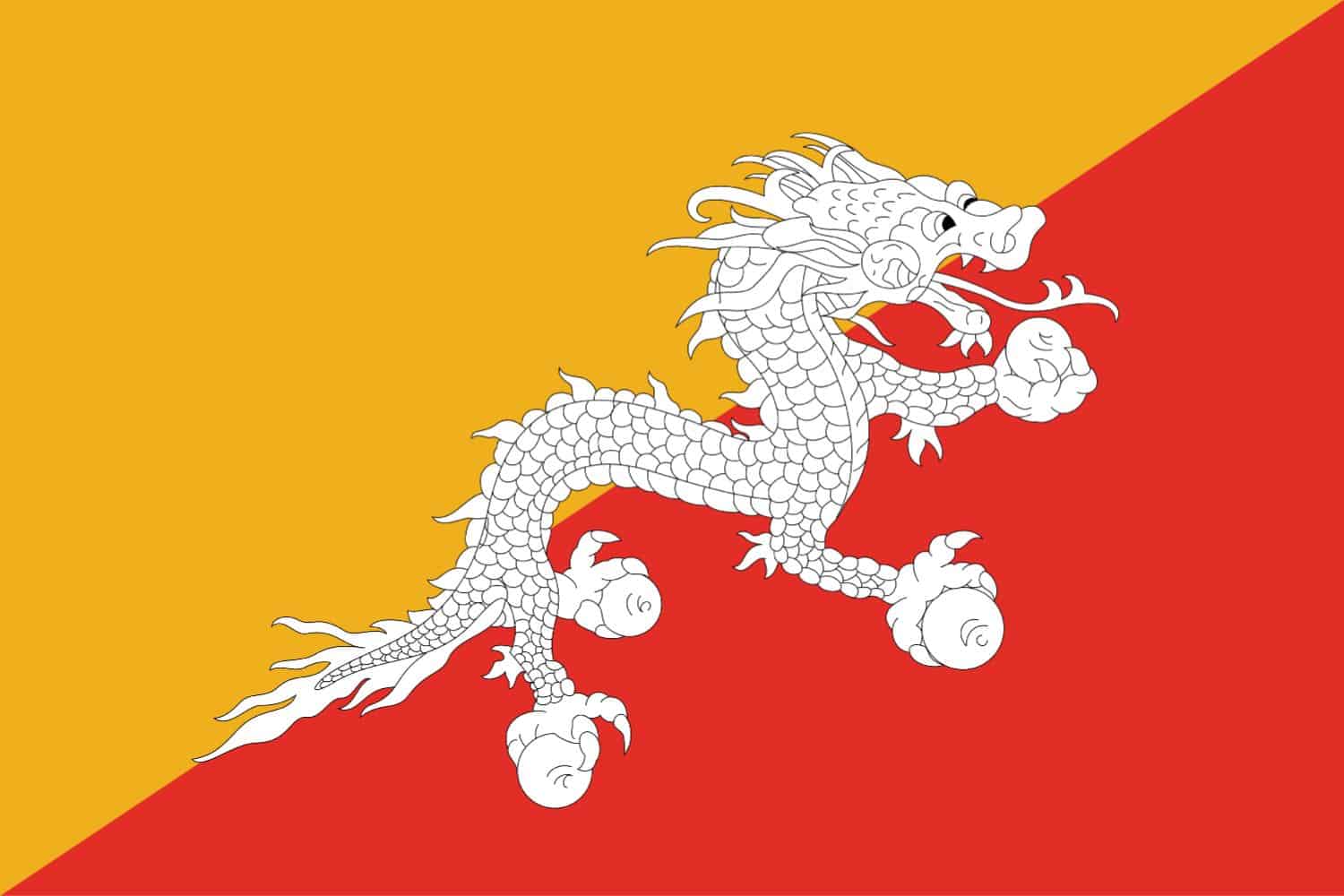
Embark on a journey of fascinating facts and lesser-known trivia about the Bhutanese flag. Discover unique features within the flag’s design that hold hidden symbolism. Uncover stories of famous incidents or events involving the flag that have left an indelible mark on the nation’s history and identity.
Rich Tapestry of History
- 1972: The current flag of Bhutan was standardized on June 2, reflecting the spirit and culture of the Bhutanese people.
- Colors and Symbolism: The yellow color symbolizes the civil tradition and temporal authority of the king, while the orange represents the Buddhist spiritual tradition. The dragon in the middle stands for the protection of the country.
- Druk, The Thunder Dragon: The white dragon on the flag is known as Druk, symbolizing the purity and loyalty of the diverse Bhutanese people, holding a profound significance in Bhutan’s mythology and culture.
- National Identity: The flag embodies Bhutan’s rich history, cultural heritage, and the nation’s ongoing pursuit of happiness, prosperity, and spiritual awakening.
These historical facts highlight significant moments in the history of the Bhutanese flag, showcasing its role in shaping Bhutan’s national identity and symbolizing its traditions and aspirations throughout the years.
Flag-Related Symbols and Emblems
A flag is not alone in representing the nation’s identity. Explore additional national symbols and emblems closely associated with Bhutan, understanding their significance and how they relate to the flag. Delve into their historical and cultural roots, further enriching your understanding of Bhutan’s heritage. It’s easy to travel and make a Bhutan tour to visit the country’s best destinations.
Symbolisms of the Bhutan Flag
The flag of Bhutan holds several symbolic elements that represent the nation’s history, values, and aspirations. Here are the symbolisms of the Bhutan flag presented in itemized form:
- Orange Color: Represents the Drukpas, which are the majority of Bhutanese people, and symbolizes the secular authority of the King.
- Yellow Color: Symbolizes the authority of the Dharma or the religious practices in Bhutan.
- Dragon: The white dragon on the flag is known as the Druk, which translates to “Thunder Dragon”. It represents the protection of the country, and the jewels in its claws symbolize the wealth and prosperity of Bhutan.
- Dragon’s Snarling Mouth: Expresses the strength of the protective deities to defend Bhutan from harm.
- Flag’s Design: Reflects Bhutan’s unique culture, deep spiritual roots, and the bond between the monarchy and the Dharma.
- National Identity: The flag serves as a powerful symbol that unifies the Bhutanese people, reminding them of their shared heritage and cultural identity.
- National Aspirations: Through its design and elements, the flag embodies the aspirations and values of the Bhutanese nation, including protection, prosperity, spirituality, and unity.
These symbolisms in the flag contribute to the country’s sense of identity and pride, reflecting its historical journey and cultural significance.
Flags of Similar Countries or Regions
Examining the flags of neighboring countries or regions can provide intriguing insights. Compare and contrast the flags, exploring similarities in design, colors, or symbolism. Uncover historical and cultural connections between flags, shedding light on shared influences or distinctive identities.
Bhutanese Flag vs Nepalese Flag
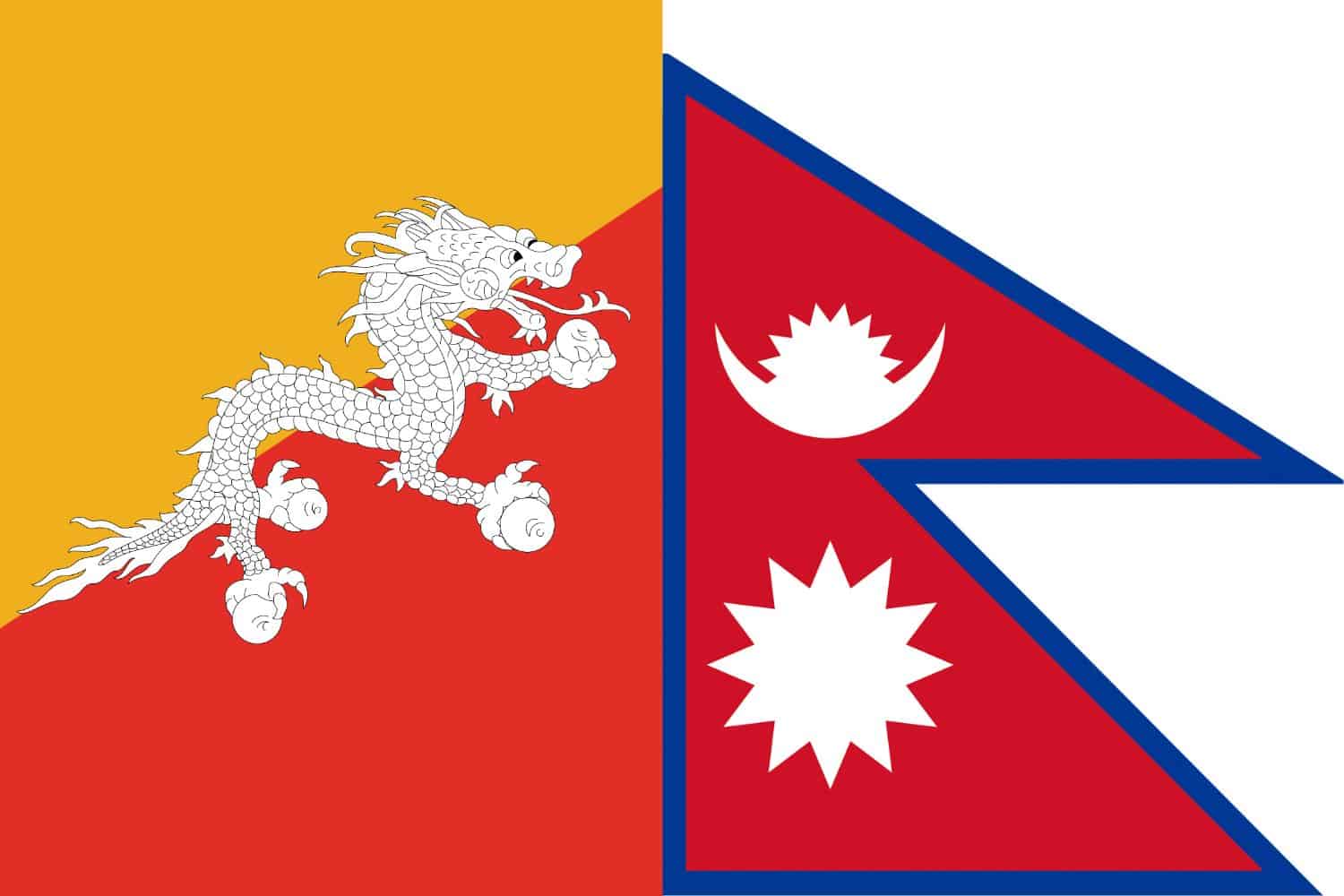
Similarity: Both flags are not the standard rectangle shape common to most world flags. They have unique shapes, with Nepal’s flag being a double-pennant shape and Bhutan’s flag having a dragon motif.
Difference: The Nepalese flag has crimson as its primary color, with dark blue borders, and features the moon and the sun. Bhutan’s flag, on the other hand, features a white dragon across a background divided diagonally – orange on the top and yellow at the bottom.
Bhutanese Flag vs Indian Flag
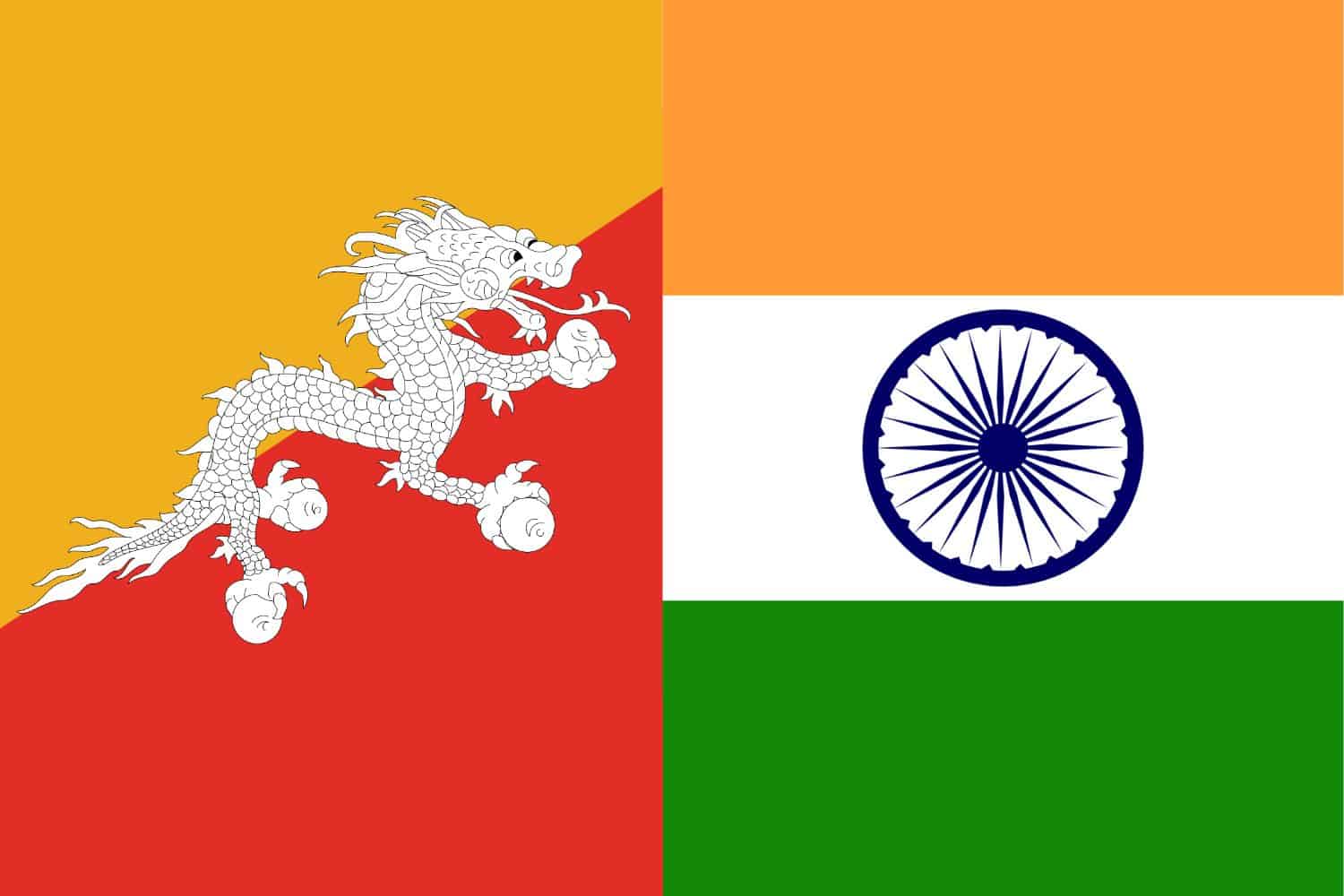
Similarity: Both flags have a horizontal stripe design.
Difference: The Indian flag consists of saffron, white, and green horizontal stripes with a blue Ashoka Chakra in the center. In contrast, the Bhutanese flag is divided diagonally with a white dragon motif.
Bhutanese Flag vs Bangladeshi Flag
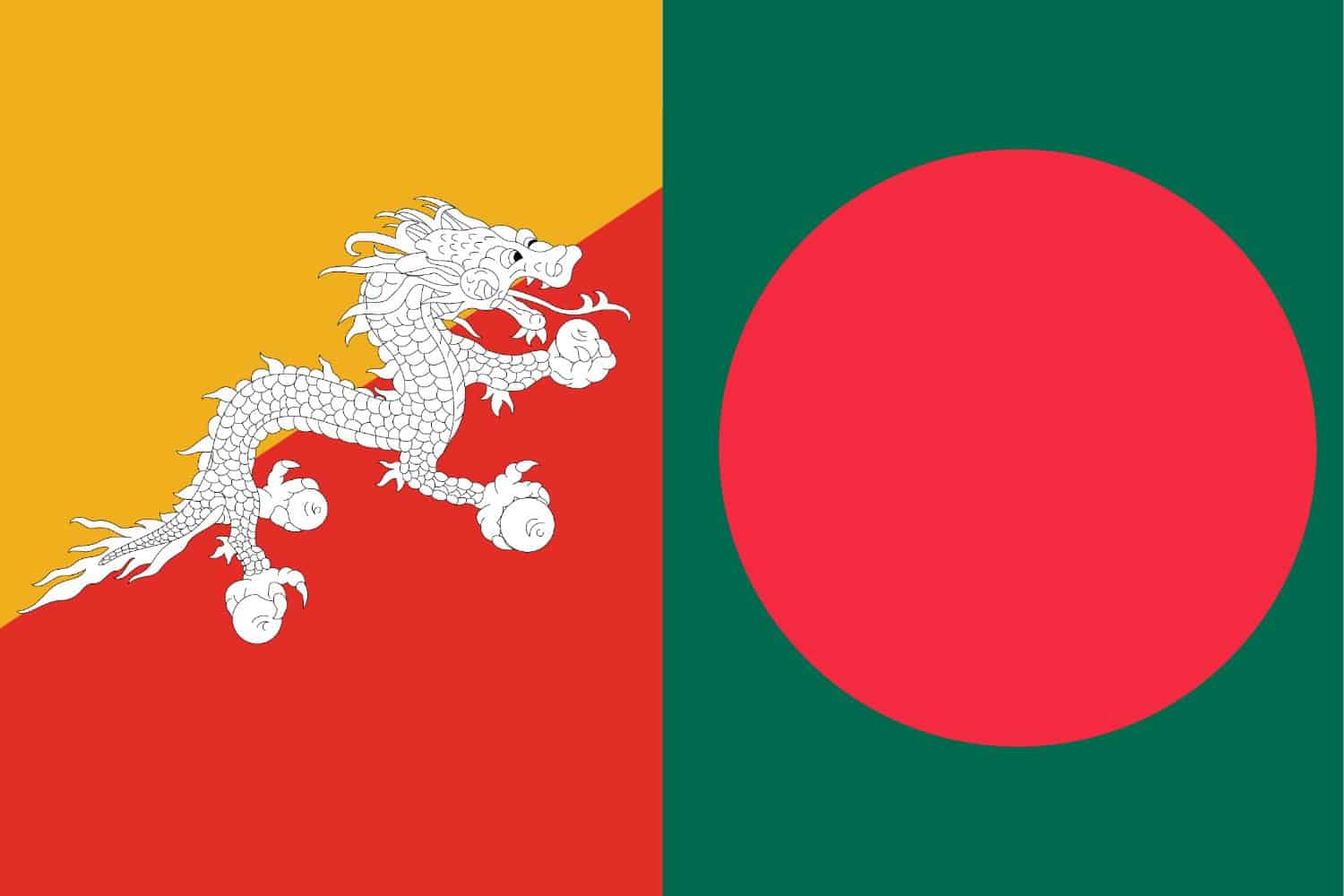
Similarity: Both flags prominently feature a significant symbol against a solid field.
Difference: The Bangladeshi flag showcases a red circle against a green field, representing the sun and the lushness of the land. Bhutan’s flag presents a white dragon, representing the protection of the country, against a diagonally divided field of orange and yellow.
Bhutanese Flag vs Tibetan Flag
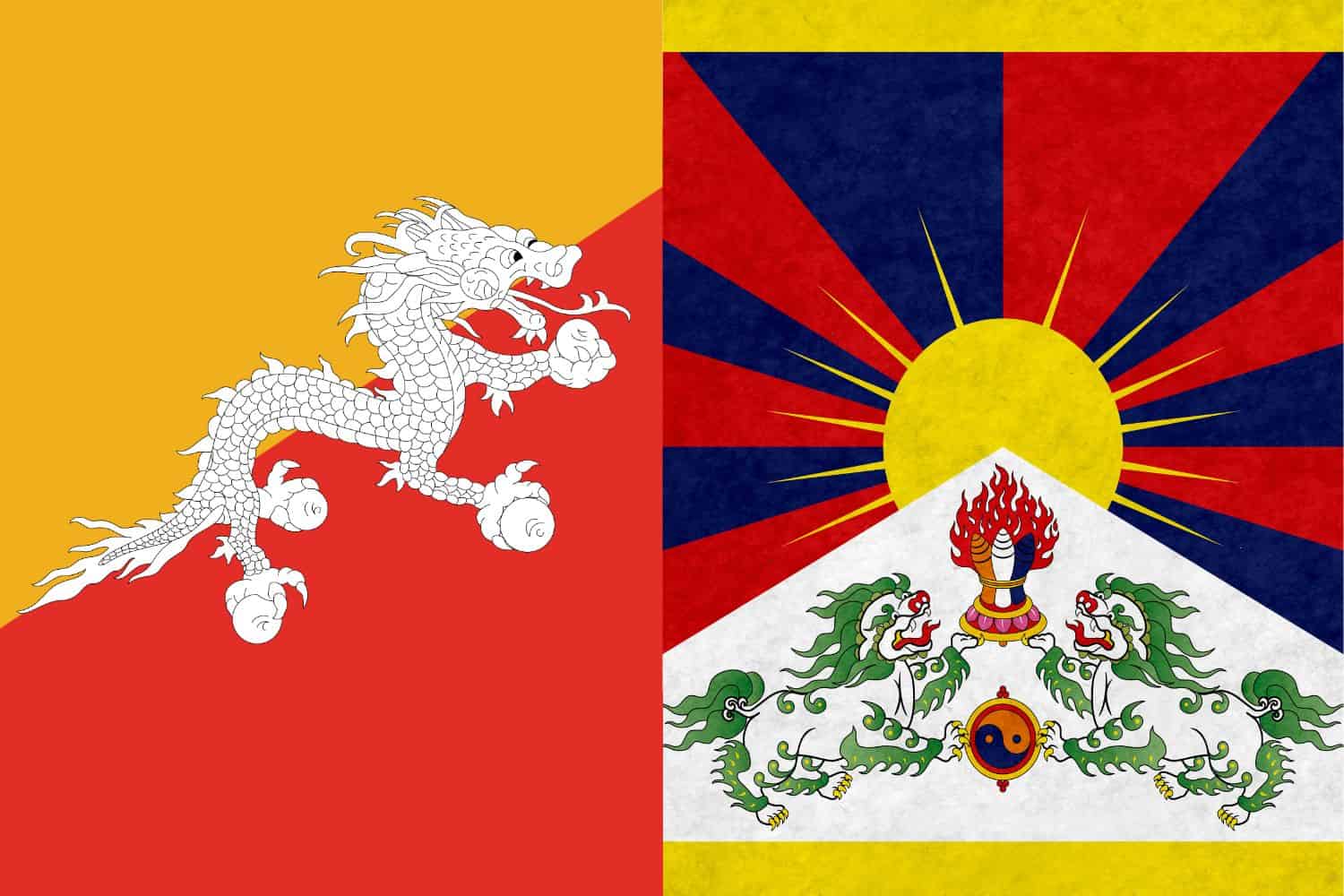
Similarity: Both flags use vibrant colors and integrate significant regional symbols.
Difference: The Tibetan flag is made up of multiple colors including blue, red, and yellow, and features the ‘Snow Lion’. Bhutan’s flag has a diagonally divided field of orange and yellow with a white dragon across.
Bhutanese Flag vs Chinese Flag
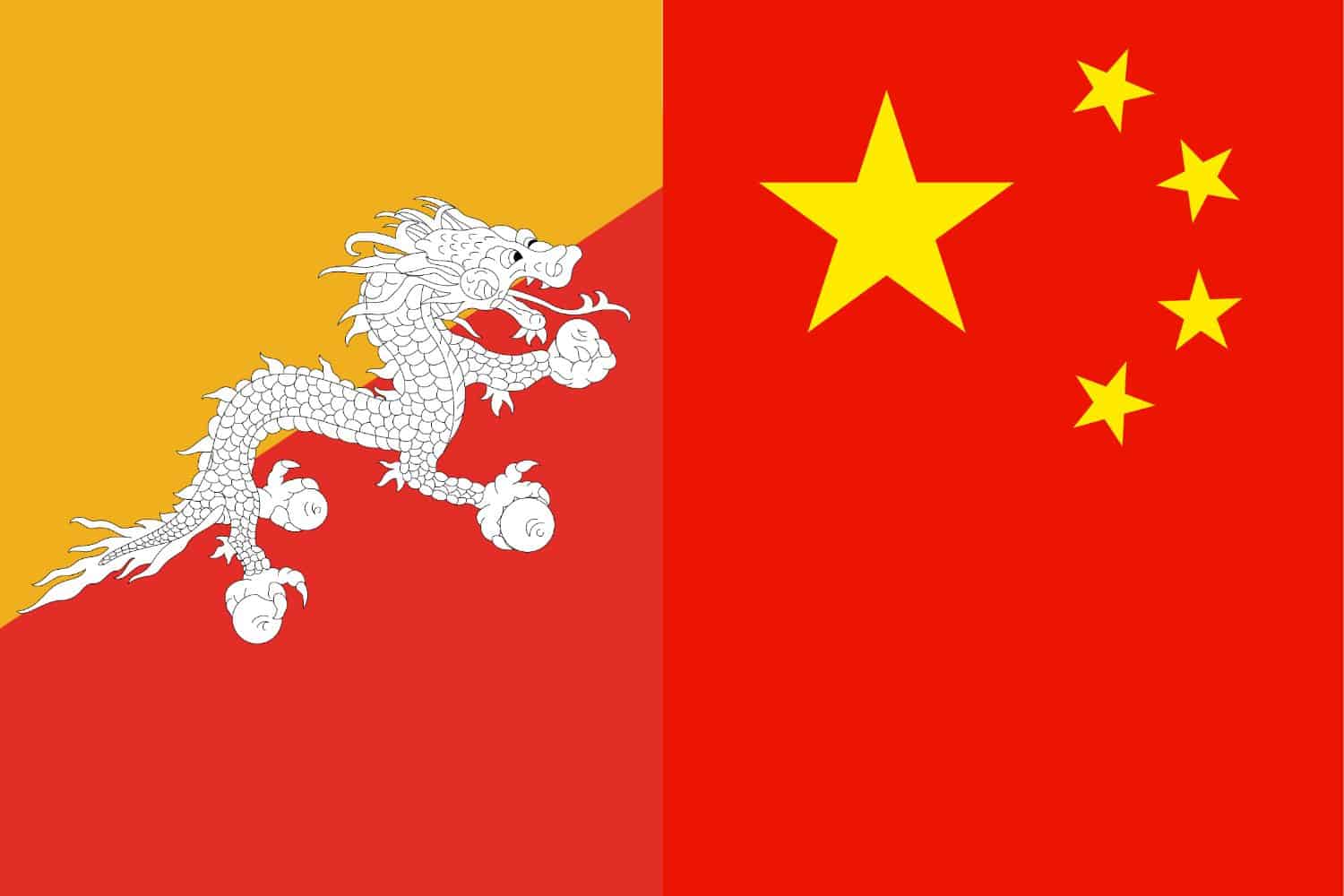
Similarity: Both flags utilize red as a significant color.
Difference: The Chinese flag is predominantly red with five golden stars (one large and four smaller ones) on the top-left corner. Bhutan’s flag features a diagonally divided field with a white dragon in the center.
Bhutanese Flag vs Myanmar (Burmese) Flag
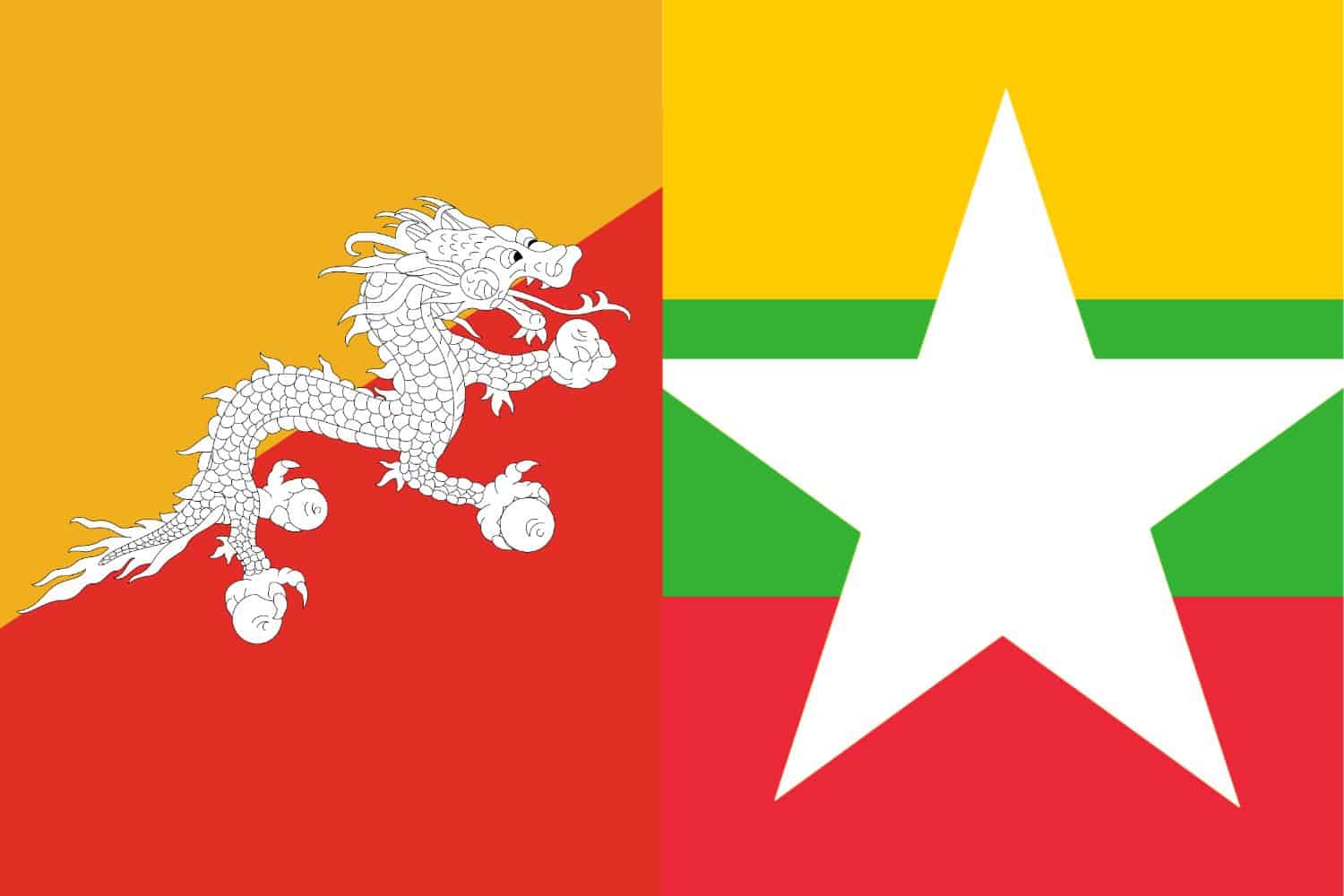
Similarity: Both flags use horizontal stripes.
Difference: The Myanmar flag consists of three horizontal stripes of yellow, green, and red. The Bhutanese flag is divided diagonally with a white dragon motif in between the colors of orange and yellow.
Frequently Asked Questions (FAQs)
Discover answers to common questions related to the Bhutanese flag picture. From its historical origins to the symbolism behind its elements, find concise and informative responses that address inquiries commonly posed by those curious about Bhutan’s flag.
What do the colors on the Bhutan flag symbolize?
The orange half represents the spiritual tradition in Bhutan, while the yellow half symbolizes the temporal power and secular authority of the king. The dragon in the center, known as Druk (the Thunder Dragon), signifies the protection of the country.
Is there any historical significance behind the Bhutan flag’s design?
Yes, the design reflects Bhutan’s dual commitment to both its spiritual tradition and the leadership of the monarchy, while the dragon has been a symbol of Bhutan for centuries, representing its local Tibetan name, Druk Yul, or the Land of the Thunder Dragon.
What does the dragon on the Bhutan flag represent?
The dragon, Druk, symbolizes the protection of Bhutan, its sovereign power, and the defense of Bhutanese territory.
Are there any religious connotations associated with the Bhutan flag?
The orange part of the flag represents the Drukpa Lineage of Tibetan Buddhism, which is the dominant religion in Bhutan.
How does the Bhutan flag reflect the country’s geographical diversity?
While the flag does not directly reflect geographical diversity, its colors and symbols encapsulate the cultural and spiritual richness of Bhutan.
Has the design of the Bhutan flag changed over time?
While the basic elements such as the dragon and the colors have remained, the design was standardized in 1969 to the current version we see today.
Is the Bhutan flag associated with any specific national holidays or celebrations?
Yes, the Bhutan flag is prominently displayed during national holidays such as the National Day of Bhutan, as well as during religious and cultural festivals.
Are there any guidelines for the respectful handling and display of the Bhutan flag?
Yes, the flag should be treated with respect, not allowed to touch the ground, and hoisted and lowered with dignity during official ceremonies and events.
Does the Bhutan flag have any similarities to other flags in the region?
The flag’s unique design with the dragon in the center makes it distinctly Bhutanese, though dragons are symbols found in other East and South Asian cultures.
What does the Bhutan flag symbolize for the Bhutanese people?
The flag serves as a symbol of national pride, unity, and the melding of spiritual and temporal realms in Bhutanese life, evoking a deep sense of belonging and patriotism.
More About Bhutan
[the-post-grid id=”50343″ title=”Bhutan Main page”]
